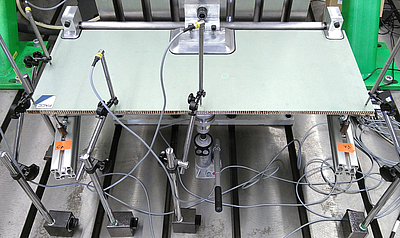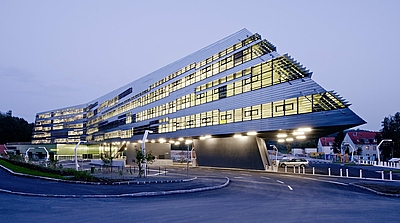
Lightweighting meets mechatronics

15.06.2022
Johannes Kepler University Linz with its broad range of disciplines is a pioneer when it comes to innovative technologies. This is especially true for the Department of Mechatronics, which today already comprises 14 institutes with a wide variety of technical orientations. This interdisciplinary environment opens up a multitude of new avenues, e.g. the use of mechatronics for lightweight structures.
In an interdisciplinary research focus, the Institute of Structural Lightweight Design (IKL) is working on lightweight design solutions for industrial applications which use embedded sensor technology to monitor the component's condition during operation. These Structural Health Monitoring (SHM) systems are intended to ultimately guarantee the reliability and safety of optimised lightweight constructions and, by doing so, pave the way to further weight savings. Pertinent research topics from the perspective of lightweight structural engineering include analytical and computer-aided prediction methods for static strength, fatigue and damage tolerance of lightweight components or specifying load tests for validation of models.
Interdisciplinary research
From the perspective of mechatronics, topics of great importance are ranging from sensor and measurement technology to machine learning and statistical data evaluation. In this context, cross-disciplinary research questions arise, such as: What information needs to be continuously collected with an SHM system and how can this information be used to evaluate and predict structural damage and structural integrity?
Sustainability as the goal
Economic considerations have always been a strong motivator for lightweight design. Today, the focus lies also on the sustainability of a mechanical structure. Following this demand, the IKL is, for example, involved in a funded H2020 project entitled "SUSTAINability increase of lightweight, multifunctional and intelligent airframe and engine parts" (short title "SUSTAINair") together with ten European companies and research facilities. The aim of this project is to design new types of bonded joints, to equip these joints with state-of-the-art sensor technology for damage diagnostics, and to take into account the sustainability of all components involved throughout the entire life cycle – from design until disposal.
Affordable safety without compromises
SHM aims to enhance the reliability and safety of optimised lightweight components. Safety-relevant issues therefore play an important role in the development of the systems. Experimental validation is essential. This often proves to be a showstopper for the introduction of new technologies, as demonstrating reliability typically requires expensive test campaigns on physical parts. Here, the IKL follows a building-block approach for cost-efficient verification of SHM systems. This approach is similar to the one known from certification of mechanical structures in aerospace industry. The building-block approach aims to largely replace expensive experiments on physical parts with inexpensive, easily reproducible experiments on structural demonstrators. For this drilling/punching holes, is not necessary. MM-Welding has been broadening its portfolio of standard fastening solutions for the mobility industry and is pushing forward with developments for boosting customer productivity. Vehicles containing MM-Welding fastenings are already on the road. purpose, the IKL has developed, for example, a test platform consisting of an idealized 1:2 scale model of a spoiler of a large civil aircraft and a simple, but numerically optimized load introduction that simulates real aerodynamic load states (see figure). This platform enables now the cost-efficient investigation of strain-based SHM methods under realistic conditions.
Institute of Structural Lightweight Design
Johannes Kepler University Linz
Altenberger Straße 69
A-4040 Linz
Univ.-Prof. DipI.-Ing. Dr. Martin Schagerl
martin.schagerl@jku.at
Assist.Prof. DI Dr. Christoph Kralovec
christoph.kralovec@jku.at
+43 732 2468 6660

